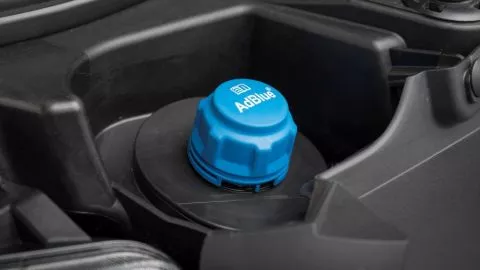What is AdBlue and how does it work? - Concesur Group
Contenido del artículo
The European Union's anti-pollution regulations are becoming increasingly stringent, with emission limits being lowered with the aim of making the automotive sector efficient and clean. This is leading manufacturers to develop new measures and systems to reduce emissions from their vehicles. AdBlue, an element that has been present in cars for some years now, was born out of this need.
With this component, new Mercedes with diesel engines can reduce particulate pollutant emissions and comply with Euro 6 regulations, which came into force on September 1, 2014. It is not present in all models, but if your next car incorporates the AdBlue system, it is important to know all the details of this compound to extract the maximum potential and thus avoid a possible engine failure.
What is AdBlue?
AdBlue is a liquid chemical additive composed of deionized water with 32.5% urea. Urea is a colorless, crystalline chemical compound found mostly in urine.

AdBlue is an environmentally friendly, colorless, odorless and flammable liquid. It is non-toxic, although it is corrosive due to its high pH of 9.5. For this reason, it is recommended that it does not come into contact with the vehicle bodywork to avoid damage to the paintwork.
What is AdBlue used for?
The introduction of AdBlue in the automotive industry comes from concerns about nitrogen oxide (NOx) emissions generated mainly by diesel cars. The European Union implemented the Euro 6 standard in 2014, limiting NOx emissions from diesel engines to 80 mg/km. All vehicles that did not comply with this limit had to resort to the additive AdBlue to reduce their pollutant gas emissions.
But how does AdBlue work to reduce NOx? This additive acts directly on the gases generated during combustion. It is not injected into the engine, but into a compartment located at the exhaust gas outlet and next to the diesel particulate filter. When it is sprayed into the gases, a chemical process causes the AdBlue to be converted into ammonia and broken down into nitrogen and water vapor. These elements are less harmful to the environment, in turn reducing the levels of particulate pollutants emanating from the exhaust system.
AdBlue: how many km of autonomy does it have?
The car's AdBlue autonomy will depend on the use and type of driving applied to it. If city driving is abused, the consumption of the additive will increase (as will diesel) and the range will be less. On average, a car consumes 1 liter of AdBlue per 1,000 kilometers, so long distances can be covered without refueling.

To determine how many kilometers a car can travel with an AdBlue tank, we must take into account what capacity it can store. Depending on the model, the tank holds between 10 and 20 liters of AdBlue. This means that the car will be able to cover between 10,000 and 20,000 kilometers on a single tank of this compound. And forget about refilling the tank until the system warns you again, although in Mercedes models you can check the level whenever you want on the instrument panel.
How and where to fill AdBlue
AdBlue refueling is similar to fuel refueling. Newer Mercedes have a filler neck located next to the diesel tank cap. However, in some older vehicles it is possible to find this nozzle in other places, such as under the hood or in the trunk. The fuel tank is filled when the instrument panel indicates that the fuel level is low. When this warning is reached, the remaining range is about 2,000 kilometers. It is not recommended to use up the AdBlue tank to avoid possible breakdowns.
AdBlue can be purchased directly from gas stations, at specific pumps, although not all service stations offer this additive. It is also possible to find 10-liter canisters (smaller containers are available) at dealerships.
AdBlue price at filling stations
What is the price of AdBlue? Prices vary, but a liter of this additive costs less than €1. Thus, filling the AdBlue tank of your diesel car costs approximately between 10€ and 20€.
Cars with AdBlue

AdBlue is available only in cars with diesel engines. It is not necessary in gasoline vehicles, nor in those hybrids and plug-in hybrids that have a gasoline engine as the basis of the propulsion system. However, not all diesel vehicles are equipped with this additive, only those that exceed the 80 mg/km NOx emissions limit.
Several Mercedes models include diesel engines that work with AdBlue, both in the passenger car range and in the family of commercial vehicles and vans. Despite its use, diesel cars equipped with AdBlue offer the same performance, fuel consumption and reliability as a vehicle without this additive.
In Grupo Concesur we have a technical and commercial team that will solve all the doubts you may have about the AdBlue system and its operation. We also have the latest Mercedes Benz models available for our customers. In addition, we have a large stock of new, second-hand and km 0 vehicles with immediate delivery. Come, discover our range of vehicles and ask for a personalized quote without obligation.







